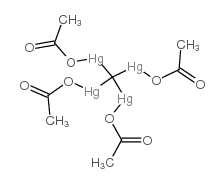25201-30-3
| 中文名 | 四(乙酰氧基汞)甲烷 |
|---|---|
| 英文名 | acetyloxy-[tris(acetyloxymercurio)methyl]mercury |
| 英文别名 | tamm |
| 熔点 | 255-275ºC (dec.) |
|---|---|
| 分子式 | C9H12Hg4O8 |
| 分子量 | 1050.55000 |
| 精确质量 | 1055.94000 |
| PSA | 105.20000 |
| LogP | 0.26000 |
| 储存条件 | 密闭于阴凉干燥环境中 |
| 稳定性 | 遵照规定使用和储存则不会分解。 |
| 分子结构 | 1、摩尔折射率:无可用 2、 摩尔体积(cm3/mol):无可用 3、 等张比容(90.2K):无可用 4、 表面张力(dyne/cm):无可用 5、 极化率:无可用 |
| 计算化学 | 1.疏水参数计算参考值(XlogP):无 2.氢键供体数量:0 3.氢键受体数量:8 4.可旋转化学键数量:12 5.互变异构体数量:无 6.拓扑分子极性表面积105 7.重原子数量:21 8.表面电荷:0 9.复杂度:335 10.同位素原子数量:0 11.确定原子立构中心数量:0 12.不确定原子立构中心数量:0 13.确定化学键立构中心数量:0 14.不确定化学键立构中心数量:0 15.共价键单元数量:1 |
| 更多 | 1. 性状:无可用 2. 密度(g/mL,25/4℃):无可用 3. 相对蒸汽密度(g/mL,空气=1):无可用 4. 熔点(ºC):255-275 5. 沸点(ºC,常压):无可用 6. 沸点(ºC,5.2kPa):无可用 7. 折射率:无可用 8. 闪点(ºC):无可用 9. 比旋光度(º):无可用 10. 自燃点或引燃温度(ºC):无可用 11. 蒸气压(kPa,25ºC):无可用 12. 饱和蒸气压(kPa,60ºC):无可用 13. 燃烧热(KJ/mol):无可用 14. 临界温度(ºC):无可用 15. 临界压力(KPa):无可用 16. 油水(辛醇/水)分配系数的对数值:无可用 17. 爆炸上限(%,V/V):无可用 18. 爆炸下限(%,V/V):无可用 19. 溶解性:无可用 |
|
Section 1: Product Identification Chemical Name:Tetrakis(acetoxymercuri)methane, min. 95% CAS Registry Number:25201-30-3 Formula:C(HgOOCCH3)4 EINECS Number:none Chemical Family:organomercury compound Synonym:Carbon tetra(acetoxymercuride)
Section 2: Composition and Information on Ingredients IngredientCAS NumberPercentACGIH (TWA)OSHA (PEL) Title Compound25201-30-3100%0.01mg/m3 (Hg)1mg/10m3 (Hg) Section 3: Hazards Identification Toxic by inhalation, in contact with skin and if swallowed. Danger of cumulative effects. Prolonged exposure Emergency Overview: may permanently degrade the central nervous system. Primary Routes of Exposure:Ingestion, skin, Inhalation of dust. Eye Contact:May cause mild to severe irritation of the eyes. May deposit mercury in the lens of the eye. Skin Contact:May cause mild to severe irritation of the skin. May be absorbed through the skin. Dust may cause severe respiratory and gastrointestinal distress, and may damage the central nervous Inhalation: system. Ingestion:May cause lack of appetite, abdominal cramps, vomiting, kidney failure and paralysis. Poison. Stomach upset and pain, mouth pain, vomiting, excessive salivation, urine production stops, urine Acute Health Affects: products appear in the blood, ataxia (difficulty in moving). The chronic effects of mercury poisoning include stomatitis, tremors, psychic disturbances, excessive Chronic Health Affects:salivation, dermatitis, and pain on chewing. Other effects include loss of memory, insomnia, lack of confidence, irritability and depression, speech and gait impairment. NTP:No IARC:No OSHA:No SECTION 4: First Aid Measures Immediately flush the eyes with copious amounts of water for at least 10-15 minutes. A victim may need Eye Exposure: assistance in keeping their eye lids open. Get immediate medical attention. Wash the affected area with water. Remove contaminated clothes if necessary. Seek medical assistance if Skin Exposure: irritation persists. Remove the victim to fresh air. Closely monitor the victim for signs of respiratory problems, such as difficulty Inhalation: in breathing, coughing, wheezing, or pain. In such cases seek immediate medical assistance. Seek medical attention immediately. Keep the victim calm. Give the victim water (only if conscious). Induce Ingestion: vomiting only if directed by medical personnel. SECTION 5: Fire Fighting Measures Flash Point:not applicable Autoignition Temperature:no data Explosion Limits:no data Extinguishing Medium:dry chemical, carbon dioxide, water, or foam. Fire fighters should be equipped with a NIOSH approved positive pressure self-contained breathing apparatus Special Fire Fighting Procedures: and full protective clothing. Hazardous Combustion andIf involved in a fire this material may emit toxic mercury fumes and carbon monoxide. Decomposion Products: Unusual Fire or Explosion Hazards: No unusual fire or explosion hazards. SECTION 6: Accidental Release Measures Small spills can be mixed with vermiculite, sodium carbonate or other suitable non combustible adsorbent and Spill and Leak Procedures: swept up. SECTION 7: Handling and Storage Handling and Storage:Store solid in a tightly sealed container in a cool dry place. SECTION 8: Exposure Controls and Personal Protection Eye Protection:Always wear approved safety glasses when handling a chemical substance in the laboratory. Skin Protection:Wear protective clothing and gloves. Consult with glove manufacturer to determine the proper type of glove. Ventilation:Material may form a toxic fine dust. If possible, handle the material in an efficient fume hood. If in form of fine dust and ventilation is not available a respirator should be worn. The use of respirators Respirator: requires a Respirator Protection Program to be in compliance with 29 CFR 1910.134. Ventilation:Material may form a toxic fine dust. If possible, handle the material in an efficient fume hood. Additional Protection:No additional protection required. SECTION 9: Physical and Chemical Properties Color and Form:white xtl. Molecular Weight:1050.55 Melting Point:255-275° dec. Boiling Point:no data Vapor Pressure:no data Specific Gravity:no data Odor:none Solubility in Water:insoluble SECTION 10: Stability and Reactivity Stability:air and moisture stable Hazardous Polymerization:no hazardous polymerization Conditions to Avoid:none Incompatibility:azides, fulminates and reducing agents Decomposition Products:carbon dioxide, carbon monoxide, organic fumes, and toxic mercury fumes. SECTION 11: Toxicological Information RTECS Data:No information available in the RTECS files. Carcinogenic Effects:no information available Mutagenic Effects:no information available Tetratogenic Effects:no information available SECTION 12: Ecological Information Avoid release to the environment. Very toxic to aquatic organisms. May cause long-term adverse effects in the Ecological Information: aquatic environment. SECTION 13: Disposal Considerations Disposal:Dispose of according to federal, state, and local regulations. SECTION 14: Transportation Shipping Name (CFR):Mercury compounds, solid, N.O.S. Hazard Class (CFR):6.1 Additional Hazard Class (CFR):NA Packaging Group (CFR):II UN ID Number (CFR):UN# 2025 Shipping Name (IATA):Mercury compound, solid, N.O.S. Hazard Class (IATA):6.1 Additional Hazard Class (IATA):NA Packaging Group (IATA):II UN ID Number (IATA):UN# 2025 SECTION 15: Regulatory Information TSCA:Not listed in the TSCA inventory. SARA (Title 313):Title compound: See Category Code N458 for reporting. Second Ingredient:none SECTION 16 - ADDITIONAL INFORMATION N/A |
|
生态学数据: 该物质对环境可能有危害,对水体应给予特别注意。
|
| 风险声明 (欧洲) | R33;R26/27/28 |
|---|---|
| 安全声明 (欧洲) | S13-S28-S45 |


